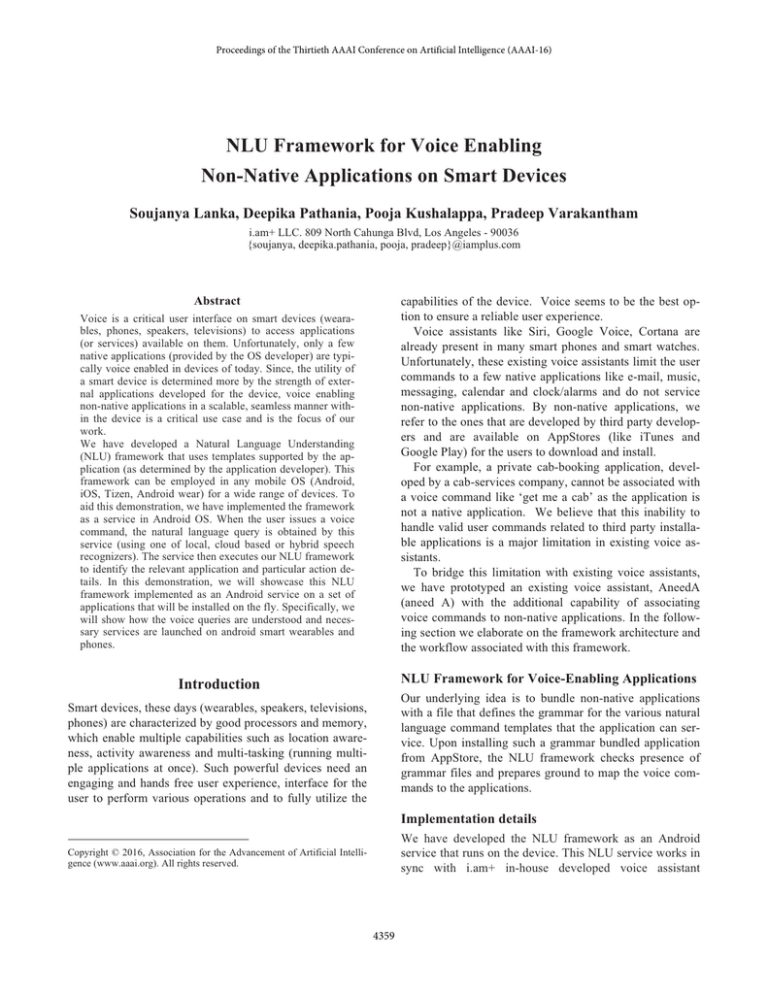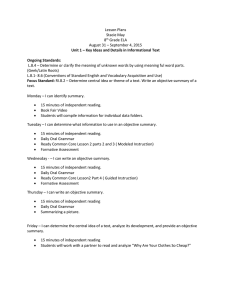
Proceedings of the Thirtieth AAAI Conference on Artificial Intelligence (AAAI-16)
NLU Framework for Voice Enabling
Non-Native Applications on Smart Devices
Soujanya Lanka, Deepika Pathania, Pooja Kushalappa, Pradeep Varakantham
i.am+ LLC. 809 North Cahunga Blvd, Los Angeles - 90036
{soujanya, deepika.pathania, pooja, pradeep}@iamplus.com
capabilities of the device. Voice seems to be the best option to ensure a reliable user experience.
Voice assistants like Siri, Google Voice, Cortana are
already present in many smart phones and smart watches.
Unfortunately, these existing voice assistants limit the user
commands to a few native applications like e-mail, music,
messaging, calendar and clock/alarms and do not service
non-native applications. By non-native applications, we
refer to the ones that are developed by third party developers and are available on AppStores (like iTunes and
Google Play) for the users to download and install.
For example, a private cab-booking application, developed by a cab-services company, cannot be associated with
a voice command like ‘get me a cab’ as the application is
not a native application. We believe that this inability to
handle valid user commands related to third party installable applications is a major limitation in existing voice assistants.
To bridge this limitation with existing voice assistants,
we have prototyped an existing voice assistant, AneedA
(aneed A) with the additional capability of associating
voice commands to non-native applications. In the following section we elaborate on the framework architecture and
the workflow associated with this framework.
Abstract
Voice is a critical user interface on smart devices (wearables, phones, speakers, televisions) to access applications
(or services) available on them. Unfortunately, only a few
native applications (provided by the OS developer) are typically voice enabled in devices of today. Since, the utility of
a smart device is determined more by the strength of external applications developed for the device, voice enabling
non-native applications in a scalable, seamless manner within the device is a critical use case and is the focus of our
work.
We have developed a Natural Language Understanding
(NLU) framework that uses templates supported by the application (as determined by the application developer). This
framework can be employed in any mobile OS (Android,
iOS, Tizen, Android wear) for a wide range of devices. To
aid this demonstration, we have implemented the framework
as a service in Android OS. When the user issues a voice
command, the natural language query is obtained by this
service (using one of local, cloud based or hybrid speech
recognizers). The service then executes our NLU framework
to identify the relevant application and particular action details. In this demonstration, we will showcase this NLU
framework implemented as an Android service on a set of
applications that will be installed on the fly. Specifically, we
will show how the voice queries are understood and necessary services are launched on android smart wearables and
phones.
NLU Framework for Voice-Enabling Applications
Introduction
Our underlying idea is to bundle non-native applications
with a file that defines the grammar for the various natural
language command templates that the application can service. Upon installing such a grammar bundled application
from AppStore, the NLU framework checks presence of
grammar files and prepares ground to map the voice commands to the applications.
Smart devices, these days (wearables, speakers, televisions,
phones) are characterized by good processors and memory,
which enable multiple capabilities such as location awareness, activity awareness and multi-tasking (running multiple applications at once). Such powerful devices need an
engaging and hands free user experience, interface for the
user to perform various operations and to fully utilize the
Implementation details
We have developed the NLU framework as an Android
service that runs on the device. This NLU service works in
sync with i.am+ in-house developed voice assistant
Copyright © 2016, Association for the Advancement of Artificial Intelligence (www.aaai.org). All rights reserved.
4359
AneedA. When a third party application is installed from
the AppStore, the service checks for any bundled grammar
file. If a grammar file is found, it registers the grammar file
to the application’s functionality and adds this grammar to
its database.
The sequence of operations (shown in Figure 1) upon receiving a voice command is as follows:
1 When user issues a voice command, the natural language query is obtained by using a (local/cloud
based/hybrid) speech recognizer.
2 If the voice assistant cannot service the natural language
query with native applications, then the command is passed
on to the local NLU service.
3 The command is checked against the list of registered
grammars maintained by the local NLU service.
4 If it matches one particular application's grammar, it
launches the associated action along with the particular
action details that could be parsed.
5 If it matches grammars of multiple applications (ex:
multiple cab-booking applications can have similar query
templates), then the voice assistant will seek input from the
user on the application of interest.
6 If the query does not match any, then it returns a FAILURE event back to the Voice Assistant, which then speaks
out that the query could not be understood/serviced.
For example, with the help of this framework, a flights
search application could be voice-enabled for voice commands like ‘find flights from <origin> to <destination>’
and ‘search for flights from <origin> to <destination>’.
The application developer creates a grammar file and
launches Flights app functionality based on the specific
user input. Please refer to Figure 1, screenshot (a) displays
the user’s speech recognition screen and in screenshot (b),
the Flights app receives the data parameters and displays
results as per the query.
Android NLU service that is built expects a JSGF grammar
(Java Speech Grammar) file. The grammar file should list
the command templates along with the data tags that need
to be sent to the application upon successful match. The
grammar file is expected to be a set of simple, disambiguous commands. In the near future, we expect to
have a component that will check for any ambiguity and
errors in grammar files.
As new applications are installed from the AppStore, the
service checks for bundled grammar files to register and
enlarge its database of grammar files; thus making it scalable as more apps are installed.
Demonstration
During the demo, we will showcase a wide variety of nonnative applications that can be triggered through voice
commands. Specifically, for multiple non-native applications of varying complexity, we will show creation of the
grammar database and execution of voice queries. To
demonstrate generality across smart devices, we will also
show case execution on a smart watch and a smart phone.
Acknowledgments
We would like to thank Will.i.am (CEO, i.am+), Chandrasekar Rathakrishnan (CPO, i.am+), TVS Deepak, Vids
Samanta, Yuan-Yi Fan and Ranu Upadhyay for their valuable feedback on the NLU framework and the support in
developing a set of demonstrable voice-enabled android
applications.
References
Java Speech Grammar Format, http://www.w3.org/TR/jsgf/
AneedA,
http://www.nuance.com/company/news-room/pressreleases/iamAneedA.docx
Ziad Al Bawab, 2009. An Analysis-by-Synthesis Approach to
Vocal Tract Modeling for Robust Speech Recognition, Ph.D.
Thesis, ECE Department, CMU.
Grammar-based NLU
We have based the NLU module on the grammar modules
available in CMU SPHINX 4 (Ziad Al Bawab 2009). The
Figure 1. NLU Framework to Voice Enable Non-Native Applications
4360





